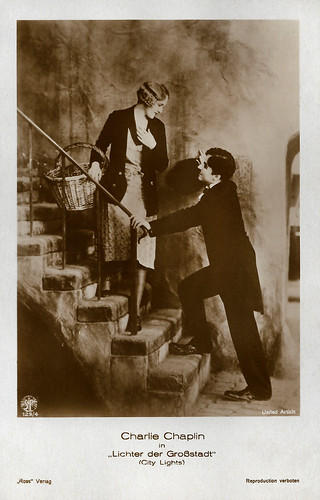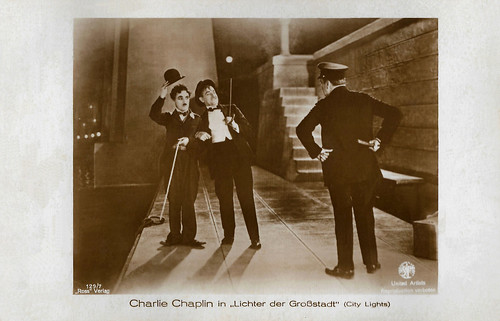Charles Chaplin played the Tramp through dozens of short films and, later, feature-length productions. In only a handful of films, he played characters other than the little tramp. The Tramp was closely identified with the silent era and was considered an international character. When the sound era began in the late 1920s, Chaplin refused to make a talkie featuring the character. City Lights (1931) featured no dialogue.

German postcard by Ross Verlag, no. 5709/1, 1930-1931. Photo: SF / United Artists. Charlie Chaplin in City Lights (Charles Chaplin, 1931).

French postcard in the 'Centenaire de la Naissance de Charlie Chaplin 1889-1989' series by Bubbles Inc., Star 150, 1989. Photo: United Artists. Charlie Chaplin and Harry Myers in City Lights (Charles Chaplin, 1931).

French postcard in the 'Centenaire de la Naissance de Charlie Chaplin 1889-1989' series by Bubbles Inc., Star 175, 1989. Photo: United Artists. Charlie Chaplin in City Lights (Charles Chaplin, 1931).
Charles Chaplin called his last 'silent' film a 'Comedy Romance in Pantomime'. City Lights (1931) opens in the early morning where the mayor is dedicating a statue to the citizens of the city. After the unveiling, the crowd finds a little tramp (Charlie Chaplin) sleeping on the lap of one of the figures. As he tries to climb down, he encounters one problem after another.
City Lights (1931) tells the story of the beloved little tramp who falls in love with a blind flower girl (Virginia Cherrill) on the sidewalk. Charlie meets her when waddling down the street with his cane and derby hat, and that tiny moustache. While examining a nude statue in a shop, he is annoyed by some newsboys making fun of his tattered clothing. Then he sees the beautiful, blonde flower girl sitting at the sidewalk. After she drops the flower, Charlie notices her feeling about the sidewalk for it, thus, realising she's blind. She assumes he is a wealthy man and offers him a flower. He attentively accepts the flower with his last penny.
The noble little fellow fancies himself as a well-mannered gentleman in spite of all the circumstances that bring him down. One night by chance he meets a depressed and drunken millionaire (Harry Myers) who attempts to commit suicide by drowning. Just as Charlie is about to save him, he in turn falls into the river. The suicide attempt at the canal is one of the many comic highlights in the film.
The drunk, in gratitude for saving his life, takes Charlie under his wing to accompany him to various night clubs until dawn. By morning, the millionaire, now sober, fails to recognise or remember Charlie and orders his butler to escort this stranger out of his mansion. However, when drunk, the wealthy businessman continues to try to commit suicide. The tramp persuades the drunken millionaire not to go through with it, making himself a devoted friend. The rich gentleman becomes a generous friend.
To impress the flower girl the poor tramp uses his friend's wealth to make her fall in love with him. The only problem is that when the millionaire is sober he doesn't recognise the tramp any more. The flower girl has to pay 22 dollars of rent or she will be thrown out of her apartment. Now the tramp desperately seeks for jobs in the city to help his love to pay the rent and to get money for eye surgery. He works as a street cleaner but loses this and various other jobs. His desperate attempt to win money with boxing leads to a magical, hilariously funny boxing match.
Reading in a newspaper of a European doctor who restores sight for the blind, Charlie gives the girl $1,000 for an operation, the money offered to him by the drunken millionaire, who, after sober, accuses Charlie of robbing him, has his arrested and serving jail time.
The last five minutes of the film are heartbreaking. When the little tramp is out of prison, he meets the formerly blind girl again. She offers him a flower and when she finally says "Yes, I can see now", she realises that the little tramp is the 'wealthy' gentleman who paid for the restoration of her sight.
City Lights is a timeless classic. It displays the Tramp at his funniest, his bravest, his most romantic, and his most sympathetic. He blends into everyday life and is more or less ignored by many, laughed at by others. And only when the millionaire is drunk does he 'see' the tramp as a friend. In the final scene, when the flower girl finally sees him, Chaplin's former slapstick character has become a living, breathing human being.

German postcard by Ross Verlag, no. 129/4. Photo: United Artists / SF. Charlie Chaplin and Virginia Cherrill in City Lights (Charles Chaplin, 1931).

German postcard by Ross Verlag, no. 129/5, 1930-1931. Photo: SF / United Artists. Charlie Chaplin, Eddie Baker, and Hank Mann in City Lights (Charles Chaplin, 1931).

German postcard by Ross Verlag, no. 129/6. Photo: United Artists / SF. Charlie Chaplin and Harry Myers in City Lights (Charles Chaplin, 1931).

German postcard by Ross Verlag, no. 129/7. Photo: United Artists. Charlie Chaplin and Harry Myers in City Lights (Charles Chaplin, 1931).
Source: IMDb.

German postcard by Ross Verlag, no. 5709/1, 1930-1931. Photo: SF / United Artists. Charlie Chaplin in City Lights (Charles Chaplin, 1931).

French postcard in the 'Centenaire de la Naissance de Charlie Chaplin 1889-1989' series by Bubbles Inc., Star 150, 1989. Photo: United Artists. Charlie Chaplin and Harry Myers in City Lights (Charles Chaplin, 1931).

French postcard in the 'Centenaire de la Naissance de Charlie Chaplin 1889-1989' series by Bubbles Inc., Star 175, 1989. Photo: United Artists. Charlie Chaplin in City Lights (Charles Chaplin, 1931).
Finally, a living, breathing human being
Charles Chaplin called his last 'silent' film a 'Comedy Romance in Pantomime'. City Lights (1931) opens in the early morning where the mayor is dedicating a statue to the citizens of the city. After the unveiling, the crowd finds a little tramp (Charlie Chaplin) sleeping on the lap of one of the figures. As he tries to climb down, he encounters one problem after another.
City Lights (1931) tells the story of the beloved little tramp who falls in love with a blind flower girl (Virginia Cherrill) on the sidewalk. Charlie meets her when waddling down the street with his cane and derby hat, and that tiny moustache. While examining a nude statue in a shop, he is annoyed by some newsboys making fun of his tattered clothing. Then he sees the beautiful, blonde flower girl sitting at the sidewalk. After she drops the flower, Charlie notices her feeling about the sidewalk for it, thus, realising she's blind. She assumes he is a wealthy man and offers him a flower. He attentively accepts the flower with his last penny.
The noble little fellow fancies himself as a well-mannered gentleman in spite of all the circumstances that bring him down. One night by chance he meets a depressed and drunken millionaire (Harry Myers) who attempts to commit suicide by drowning. Just as Charlie is about to save him, he in turn falls into the river. The suicide attempt at the canal is one of the many comic highlights in the film.
The drunk, in gratitude for saving his life, takes Charlie under his wing to accompany him to various night clubs until dawn. By morning, the millionaire, now sober, fails to recognise or remember Charlie and orders his butler to escort this stranger out of his mansion. However, when drunk, the wealthy businessman continues to try to commit suicide. The tramp persuades the drunken millionaire not to go through with it, making himself a devoted friend. The rich gentleman becomes a generous friend.
To impress the flower girl the poor tramp uses his friend's wealth to make her fall in love with him. The only problem is that when the millionaire is sober he doesn't recognise the tramp any more. The flower girl has to pay 22 dollars of rent or she will be thrown out of her apartment. Now the tramp desperately seeks for jobs in the city to help his love to pay the rent and to get money for eye surgery. He works as a street cleaner but loses this and various other jobs. His desperate attempt to win money with boxing leads to a magical, hilariously funny boxing match.
Reading in a newspaper of a European doctor who restores sight for the blind, Charlie gives the girl $1,000 for an operation, the money offered to him by the drunken millionaire, who, after sober, accuses Charlie of robbing him, has his arrested and serving jail time.
The last five minutes of the film are heartbreaking. When the little tramp is out of prison, he meets the formerly blind girl again. She offers him a flower and when she finally says "Yes, I can see now", she realises that the little tramp is the 'wealthy' gentleman who paid for the restoration of her sight.
City Lights is a timeless classic. It displays the Tramp at his funniest, his bravest, his most romantic, and his most sympathetic. He blends into everyday life and is more or less ignored by many, laughed at by others. And only when the millionaire is drunk does he 'see' the tramp as a friend. In the final scene, when the flower girl finally sees him, Chaplin's former slapstick character has become a living, breathing human being.

German postcard by Ross Verlag, no. 129/4. Photo: United Artists / SF. Charlie Chaplin and Virginia Cherrill in City Lights (Charles Chaplin, 1931).

German postcard by Ross Verlag, no. 129/5, 1930-1931. Photo: SF / United Artists. Charlie Chaplin, Eddie Baker, and Hank Mann in City Lights (Charles Chaplin, 1931).

German postcard by Ross Verlag, no. 129/6. Photo: United Artists / SF. Charlie Chaplin and Harry Myers in City Lights (Charles Chaplin, 1931).

German postcard by Ross Verlag, no. 129/7. Photo: United Artists. Charlie Chaplin and Harry Myers in City Lights (Charles Chaplin, 1931).
Source: IMDb.
No comments:
Post a Comment